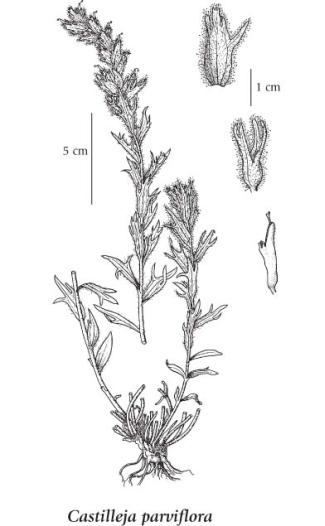Castilleja parviflora Bong.
small-flowered paintbrush
Orobanchaceae (Broom-rape family)
(Previously in Scrophulariaceae)
Introduction to Vascular Plants
small-flowered paintbrush
Orobanchaceae (Broom-rape family)
(Previously in Scrophulariaceae)
Introduction to Vascular Plants
SUBTAXA PRESENT IN BC
Species Information
General:
Perennial herb from a somewhat woody stem-base; stems several, clustered, erect or ascending, 10-30 (50) cm tall, unbranched, nearly smooth to thinly long-soft-hairy.
Leaves:
Alternate, lanceolate, 1.5-5 cm long, nearly smooth to sparsely soft-hairy, all except the lowermost cleft into 3 to 5 lateral lobes, the lobes usually much narrower than the mid-blade.
Flowers:
Inflorescence a prominently bracted terminal spike, the bracts rose-pink, magenta, crimson or sometimes whitish, lanceolate to egg-shaped, 3- to 5-lobed, long-soft-hairy, about as long as the flowers; corollas greenish, 12-25 mm long, 2-lipped, the upper lip beak-like, minutely hairy, 3-7 mm long, about as long as the tube and 3 or more times as long as the thickened, 3-toothed, lower lip; calyces 10-20 mm long, 2-lobed, these primary lobes again divided into 2 segments 3-6 mm long, coloured like the bracts; stamens 4.
Fruits:
Capsules, egg-shaped, smooth, 8-11 mm long; seeds many, the seed-coats loose and net-veined.
Illustration

If more than one illustration is available for a species (e.g., separate illustrations were provided for two subspecies) then links to the separate images will be provided below. Note that individual subspecies or varietal illustrations are not always available.
Illustration Source: The Illustrated Flora of British Columbia
Ecology
Ecological Framework for Castilleja parviflora
The table below shows the species-specific information calculated from
original data (BEC database) provided by the BC Ministry of Forests and Range.
(Updated August, 2013)
The table below shows the species-specific information calculated from
original data (BEC database) provided by the BC Ministry of Forests and Range.
(Updated August, 2013)
| Site Information |
Value / Class |
||
|
Avg |
Min |
Max |
|
| Elevation
(metres) |
1566 | 32 | 2262 |
| Slope
Gradient (%) |
29 | 0 | 300 |
|
Aspect (degrees) |
185 | 10 | 346 |
| Soil
Moisture Regime (SMR) [0 - very xeric; 4 - mesic; 8 - hydric] |
4 | 0 | 8 |
| Modal
Nutrient Regime
Class |
D | ||
| #
of field plots species was recorded in: |
120 | ||
| Modal
BEC Zone Class |
ESSF | ||
|
All BEC Zones (# of stations/zone) species was recorded in |
AT(3), BAFA(30), BWBS(2), CMA(3), ESSF(52), ICH(3), IMA(3), MH(9), SBS(4), SWB(9) | ||
|
Source:
Klinkenberg 2013
|
|||
Habitat and Range
Moist to mesic meadows, heath, streambanks and rocky slopes in the subalpine and alpine zones; frequent throughout BC; N to YT, E to SW AB and S to CA.Synonyms
Synonyms and Alternate Names:
Castilleja parviflora var. albida (Pennell) Ownbey
Castilleja parviflora var. olympica (G.N. Jones) Ownbey
Taxonomic Keys
Although in British Columbia we do not recognize varieties of this species, four varieties are recognized by the USDA (2010): var. olympica, var. albida, var. oreopola and var. parviflora. In 1984, var. olympica (previously thought to be endemic to the Olympic Peninsula) was reported by Ogilvie and Ceska (1984) for Vancouver Island.
|